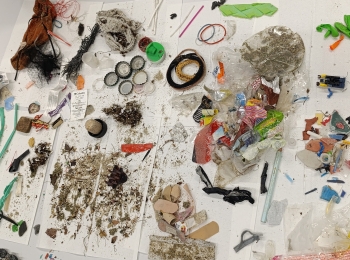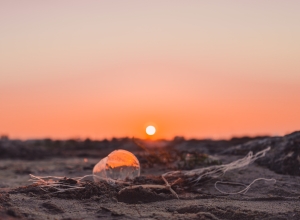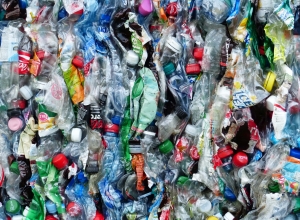Microplastic pollution in aquatic environments : insights from the Geneva Summer School
We are living in the age of plastics. Plastics, in all their diverse forms and applications, are embedded in modern life – from packaging and electronics to textiles and transportation. Yet this convenience comes with environmental consequences. As plastics degrade, they release micro- and nanoplastics into ecosystems. Microplastics are now found in oceans, lakes, rivers, soils, the atmosphere, and even within human bodies. Their omnipresence, persistence, and potential toxicity pose serious questions for environmental health, biodiversity, and sustainable development. Therefore, microplastic pollution is a pressing global concern that demands coordinated action across scientific, political, industrial, and societal domains.
A multidisciplinary approach for a multidimensional problem
Addressing this multidimensional issue was at the heart of the first edition of the Geneva Summer School on Microplastics: From Environmental Impact to Policy, Innovation, and Public Awareness (June 16-20th, 2025)1 directed by Professor Slaveykova. Hosted within the framework of the SEED 4EU+ Alliance Flagship 4: Environmental Transitions and as part of the MIRACLE project, this summer course brought together 40 participants from across the 4EU+ Alliance universities and beyond for a transformative educational experience. It served not only as a learning opportunity but also as a collaborative platform to examine the complexities of microplastic pollution, particularly in aquatic ecosystems, through multi- and interdisciplinary perspectives.
Summer School offered an interdisciplinary lens to explore the full lifecycle of microplastics and lectures covered a wide spectrum – from analytical methods for microplastic detection and quantification, to ecotoxicology, environmental risk assessment, human health concerns, and the intersection of science, innovation, and policy toward a plastic waste-free world. The course featured contributions not only from leading scientists but also from Federal Office of the Environment and from global institutions such as the United Nations Environment Programme, International Union for Conservation of Nature, and the World Economic Forum.
Engaging with experts and ideas
Participants learned from leading researchers, policy makers, and sustainability practitioners who provided insights into emerging detection technologies, toxicological studies, regulatory landscapes, circular economy and innovations.
A key component of the course was Crossed Views – World Café on Microplastic Pollution in Aquatic Environments, an informal and dynamic discussion that promoted cross-sector dialogue. Designed to mirror the spirit of a café, the format allowed participants to rotate among themed discussion tables, each focused on a specific source of microplastics: Vehicle tires and road runoff; Plastic packaging waste; Synthetic textile fibers; Personal care products and cosmetics as well as Bioplastics and alternatives to conventional plastics. Facilitated by experts from industry, government, international organizations and NGO this session allowed for an immersive and inclusive dialogue, strengthening the bridge between academia and practice.
Learning by doing: fieldwork on Lake Geneva
Theory came to life during a hands-on field trip to Geneva’s urban shoreline, including Baby Plage, Plage du Jet d’eau, and Plage des Eaux-Vives. Titled From Shoreline to Microscope: Survey of Macro- and Microplastic Pollution in Geneva’s Urban Waterfront, the excursion immersed participants in the realities of environmental research and monitoring. Students collected and analyzed plastic debris and reflected on the implications of plastic pollution for urban freshwater systems.
Communicating science
A unique and engaging element of the summer school was the 1-minute video project. Each group of students developed a short video that addressed a key issue related to microplastics in aquatic environments. This exercise allowed students to creatively synthesize scientific concepts, communicate them visually and accessibly, and work collaboratively across disciplines. More than just a communication exercise, the video project nurtured essential skills in public engagement, storytelling, and systems thinking, tools that are indispensable in today’s interconnected world.
Participants left with a deeper understanding of the science behind microplastic pollution and practical tools to take action in their communities and professions. As microplastics become a major issue of the 21st-century environmental agenda, courses like this are key to preparing future scientists, policymakers, communicators, and engaged citizens. Combining knowledge, practice, creativity, and dialogue, the Geneva Summer School on microplastics showcased how higher education can help shape solutions in our plastic age.
Link
1 https://www.unige.ch/genevasummerschools/programme/courses/microplastics
Vera Slaveykova
Prof. Vera Slaveykova is an environmental chemist with more than 25 years of experience and a full professor in Environmental Biogeochemistry and Ecotoxicology at the Department F.-A. Forel for Environmental and Aquatic Sciences and the Institute for Environmental Sciences at the University of Geneva. Over the past 12 years, she has served as the Director of the Department F.-A. Forel for Environmental and Aquatic Sciences, Vice-President, and President of the School of Earth and Environmental Sciences at the University of Geneva. Currently, she is a member of the National Research Council of the Swiss National Science Foundation and represents the University of Geneva in the UNEP Global Mercury Partnership. She also serves as Specialty Chief Editor for Biogeochemical Dynamics in Frontiers in Environmental Science.
Matea Marelja
Matea Marelja is currently a PhD student at the Institute for Environmental Sciences at the University of Geneva and a member of the Environmental Biogeochemistry and Ecotoxicology laboratory, led by Prof. Slaveykova. Her research focuses on understanding the effects of nano- and microplastics on planktonic species at the base of the food web, particularly phytoplankton and zooplankton, as well as the potential consequences on ecosystem services and biogeochemical cycles.





